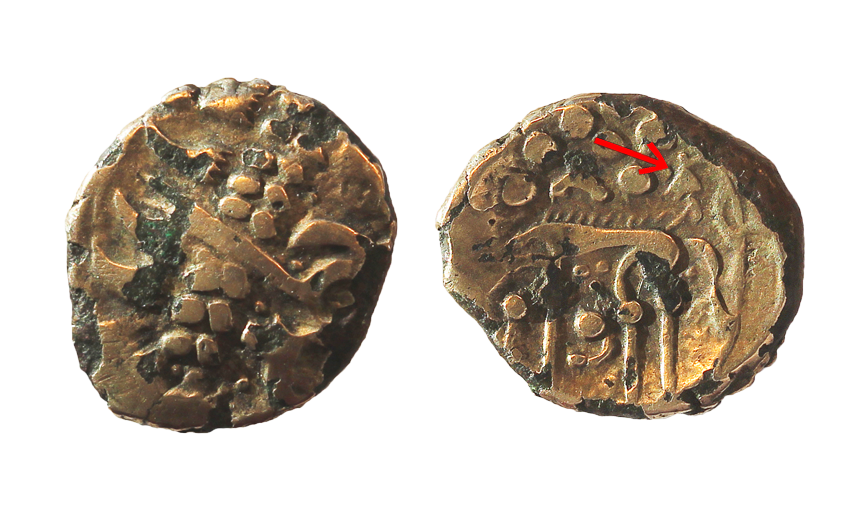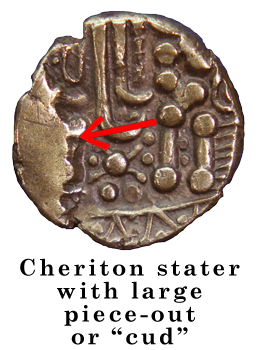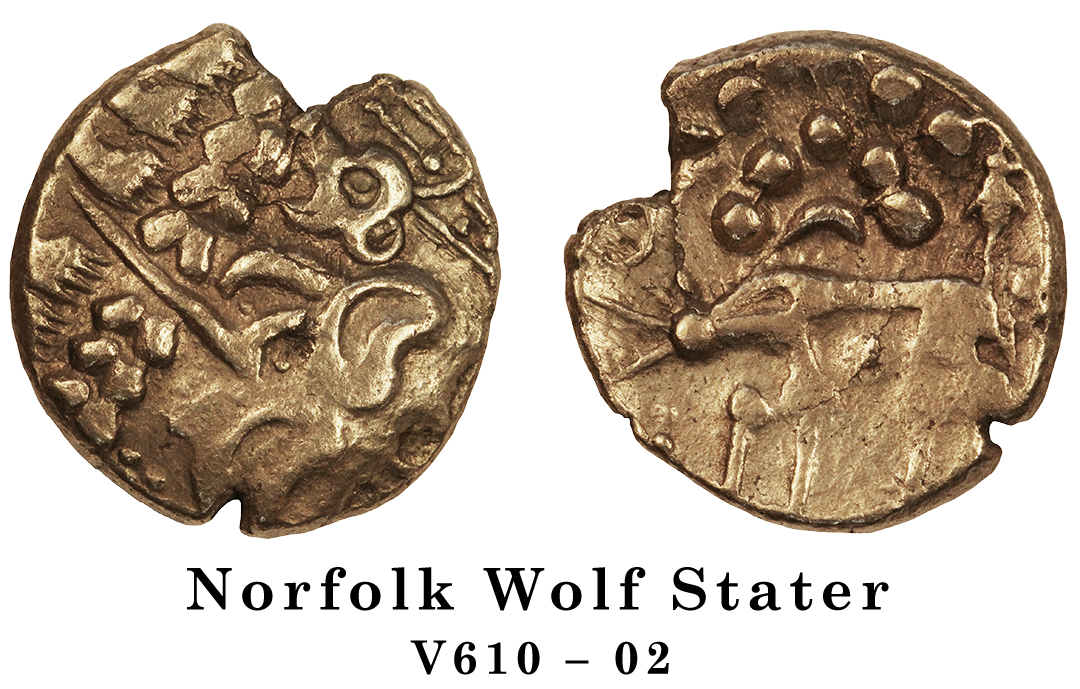
Numismatic Articles
Van Arsdell 2021b (Info)
Semiotics of Celtic Coins XIX – Dealing with Demons
By Robert D. Van Arsdell
Introduction – The Icenian Reaction to Caesar's Invasion
The previous article in this series explained the images on Trinovantian Whaddon Chase staters. The tribal leaders had dealt with Caesar's invasion of Britain with diplomacy, not aggression. They asserted this strategy benefited their people and that they had been successful leaders during the invasion. The writings of the Roman authors and the later wealth of the Trinovantes tend to corroborate the story on the coins. (Info)

The Icenian coins reveal a different reaction to Caesar's invasion. The Icenian leaders joined the Trinovantes in negotiating with the Romans, but they were initially uncertain about the prospects for success. The coins show how the Icenian leaders viewed the situation as it unfolded. In this case, the ancient Roman authors are silent about the details of the story. Only the images on the Norfolk Wolf staters give us any insight.
The Norfolk Wolf staters are the earliest coins most workers identify as Icenian. (Info) In the 1980s, the Norfolk Wolf type was thought to start about the beginning of the Gallic War, or perhaps as early as 65 BC, based on weight and gold content.
John Talbot, using additional data gathered since 1989, now suggests this coinage should start a bit later, to the middle of the Gallic War (he suggests 55 BC). This revised date has been adopted on this web site, because it also has semiotic support. (Info)
The main devices, the Apollo head and Wolf, reveal little of the message. The story is told by a succession of field objects on the obverse.
Attack of the Demons
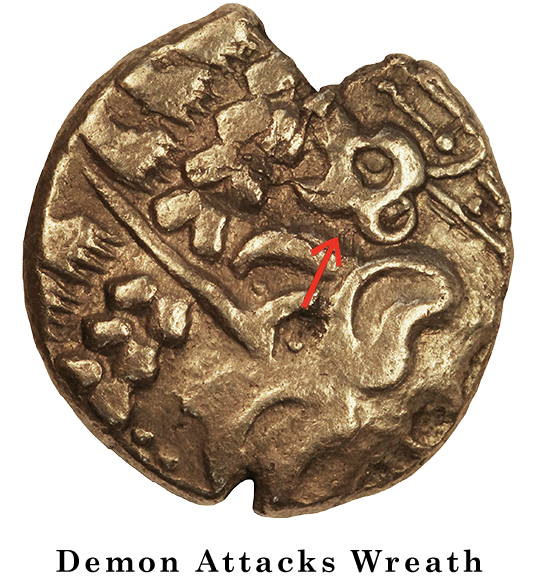
Field objects tell the story – a series of "Demons" attacking the laurel wreath on the obverse. They start off with fantastic animals, which can be described as "Dragons". Later, animal heads that look like "Bears" appear.
Dragons and Bears are just convenient labels, the images are too abstract to say what the Demons actually are. The arrow shows a "Bear" attacking the laurel wreath.
It's not a simple task to identify all the Demons. On many coins, the image is struck off the flan. Few coins show them clearly. As the dies wore out from use, the images became distorted, further complicating the the task. It's easy to double-count worn and unworn images.
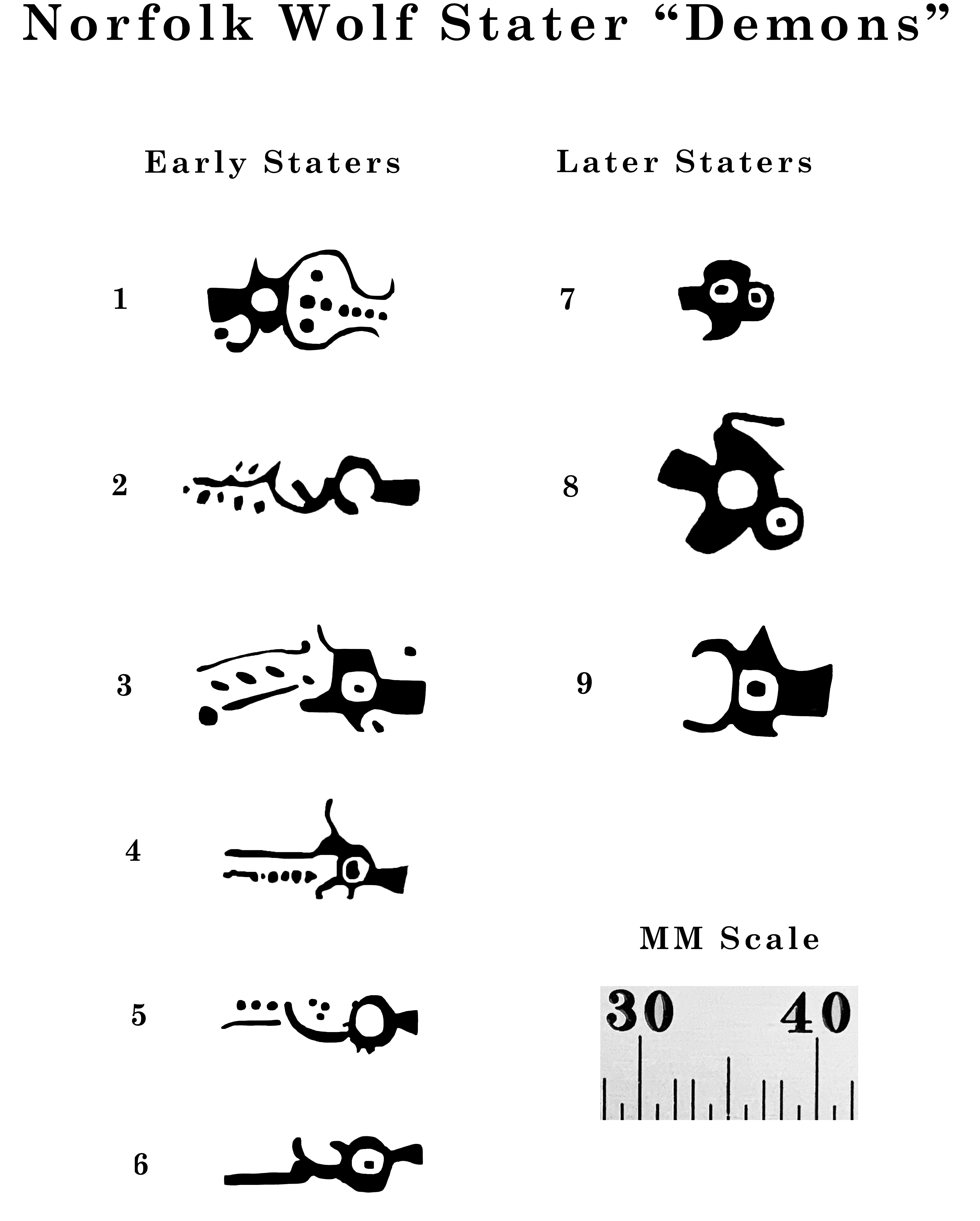
This is the Demon catalogue as it now stands. It's probably incomplete. The Demon is unknown for many dies, because that portion of the image is missing on so many coins. Thus, the following semiotic analysis is tentative, and subject to future discoveries.
So far, seven varieties of Dragons (1 thru 6, and 9) have been noted and two Bears (7 and 8). The Dragons occur throughout the series, but Bears only appear later.
The addition of Bears at some point is a tip-off that something happened. At some point in the negotiations with the Romans, the Icenian leaders changed their opinion of the situation.
Talbot's dating of the series is used here, the semiotic analysis doesn't suggest a different chronology. (Info)
Die Wear Complicates Matters
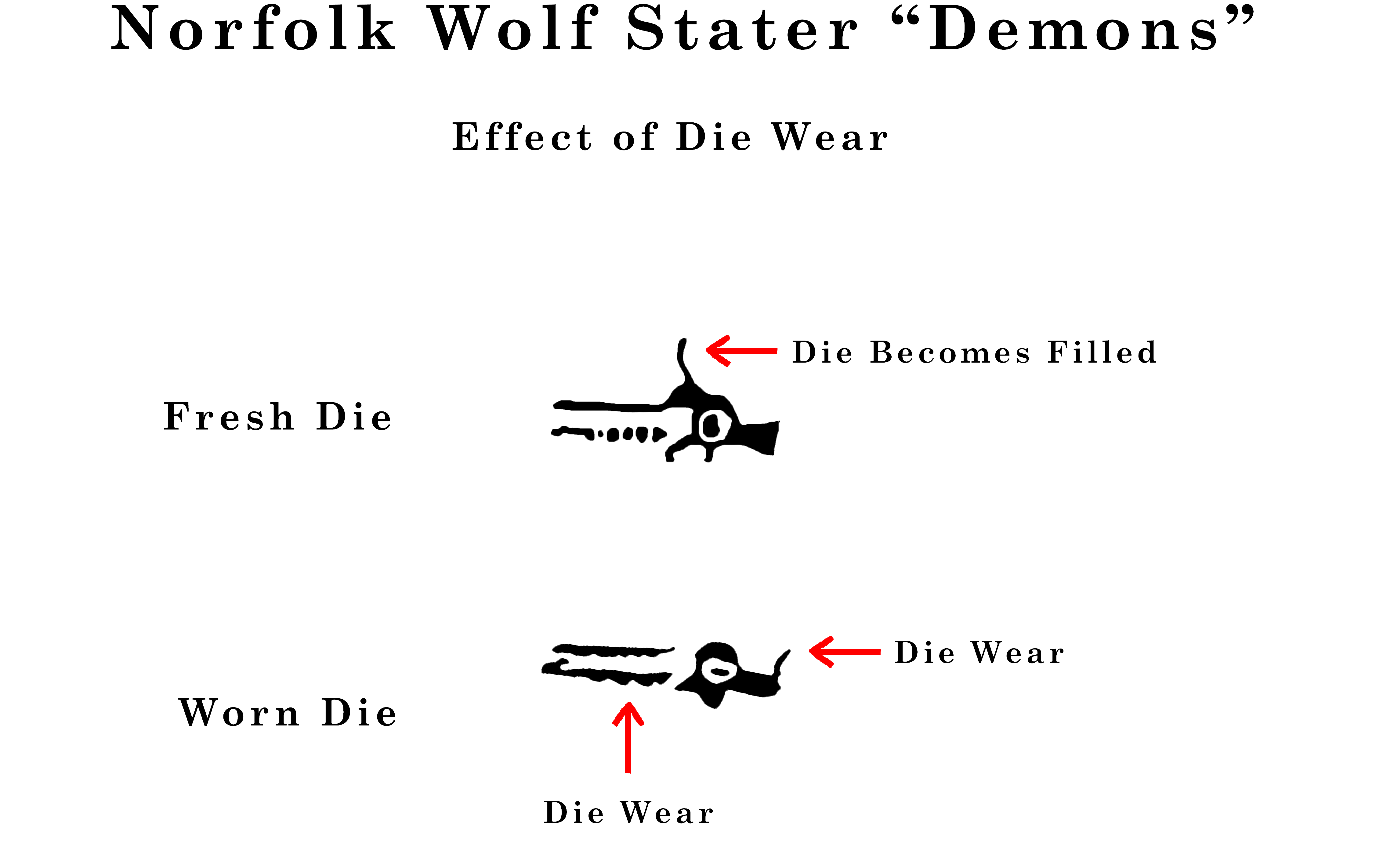
Worn Demons:
As with many Celtic coins, the dies were used until they became very worn. The Dragons were often engraved with fine lines and small pellets. As the dies were used, the engraved lines became obliterated or filled in with debris. Small cracks in the surface of the die could create "new lines" to appear. Tiny pellets could become connected to produce lines where none existed before.
In this diagram, the Dragons are drawn from two coins struck from the same die. They differ only in the wear suffered by the die:
- The line on the Dragon's head disappears as the die gets filled with debris.
- The die developed a surface crack above the Dragon's nose – causing a new line to appear.
- The tiny pellets that make up the demon's body became connected. The walls between the pellets (on the die) have broken away with continued die use.
Similar effects can be anticipated for the Bears, as well. Consequently, the appearance of any Demon might change as the die became worn. This effect has been accounted for in the semiotic analysis. The catalogue of Demons has not been artificially increased. Future workers will need to be careful not to mistake die wear for intended differences in the imagery.
Phantom Birds Appear on the Coins
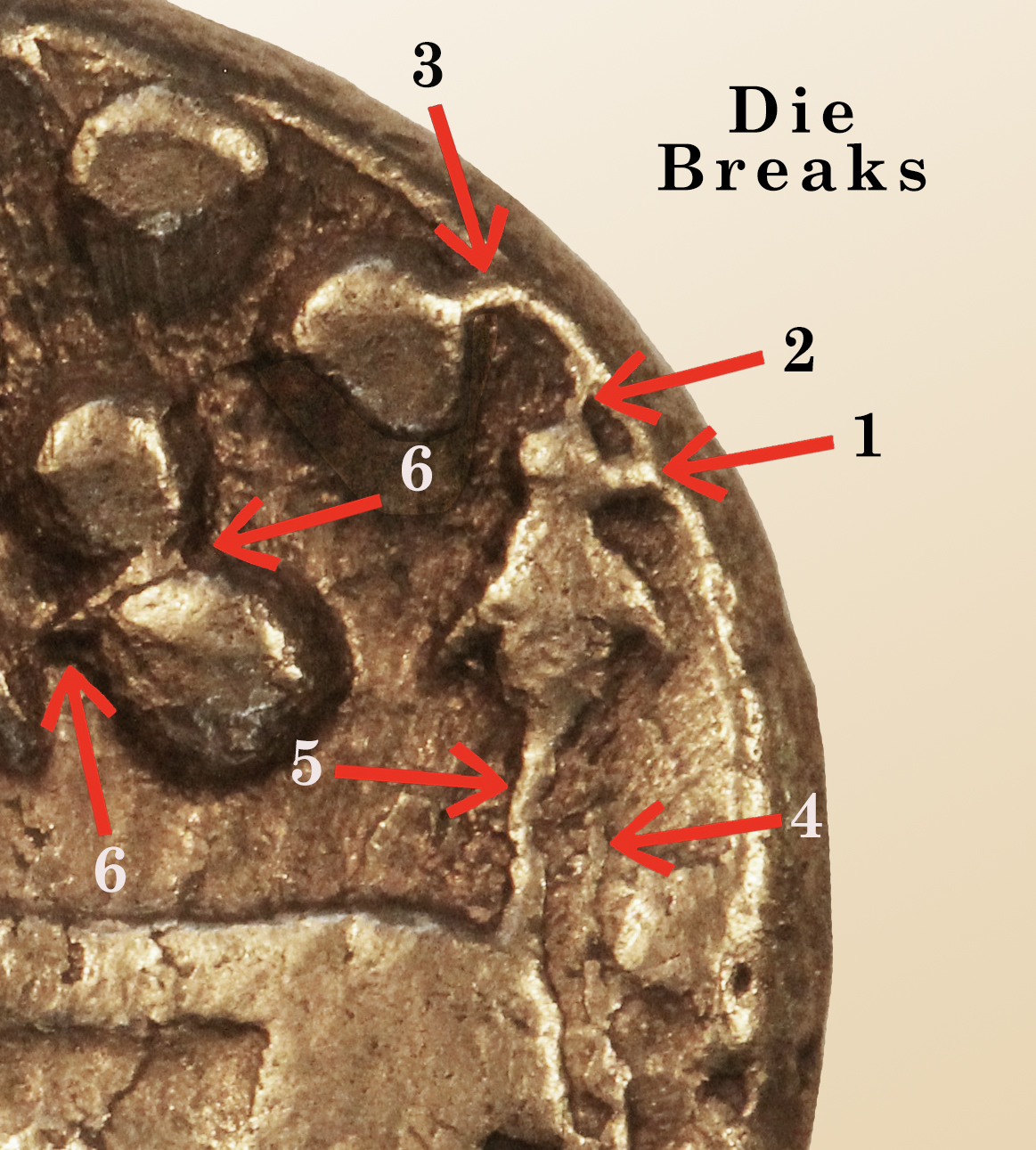
Perhaps the most bizarre effect of die wear is phantom imagery. Two workers have seen birds above the wolf and tried to identify them. The semiotic implications would suggest that birds were important to the Iceni. That importance could become a source of Stimuli in the semiotic analysis. (Info)
The bird shown here appears on Taylor's Die 32 of Die-group 12. (Info) This bird has not been identified in any previous studies, but seems to fit the same pattern of imagery.
Viewed with a 2-10X magnifying glass, the image truly looks like a bird. Strangely, the bird is best seen when looking at a photograph of the coin, instead of the coin itself.
Unfortunately, that photograph would lie to us about the image. When viewing the actual coin at 45X, using a stereomicroscope, one sees something entirely different. I must emphasize: no two-dimensional photo of this coin (such as the one given here) can reproduce the effect seen. This photo does not reveal what you see when using the scope.
However, the photo does show the places where the evidence lies. The coin was struck after the die had become very worn. The "bird" is nothing more than a pellet that has become damaged as the die broke down.
The results of die wear can be seen in the photo:
- Arrow 1 – The bird's nose is nothing more than a die-crack to the edge of the die
- Arrow 2 – A similar die-crack. It only appears on coins struck after the die had become extremely worn.
- Arrow 3 – Another die-crack – one could imagine this becoming a new bird nose if the die suffered more damage.
- Arrow 4 – The "legs" of the bird are nothing more than die-cracks. The one that created the bird's right leg has become severe. It now extends all the way behind the wolf and runs to the edge of the die. If the die had been used further, the whole edge of the die would break off, producing an enormous piece-out or cud. (Info)
- Arrow 5 – The crack that created the bird's left leg now connects to the rump of the wolf.
- Arrows labelled 6 – show the die breaking down between two pellets and a crescent. On the die, the walls that separate them are breaking away. If the die was used further, a large blob would appear above the wolf. One wonders what interpretation of the image could result.
When the die was in better shape, the impression of a bird was more convincing. The legs were not so long and the second line on top of the bird's head didn't exist yet. If a coin existed from the die when it was new (none are now known), it would show a simple pellet.
There is no bird on this coin.
It's possible the other birds seen on Norfolk Wolf staters may be nothing more than die damage. The coins involved ought to be re-examined using a stereomicroscope. Examining coins from different die-states would reveal progressive wear. This could prove whether or not there were birds on the freshly-cut dies. The work is best done using coins, not photographs.
Until this work is done, no consideration ought to be given to bird imagery as a source of Stimuli.
The Semiotic Analysis
The Circumstance Selectors
Issuing Authority: Who created the coins? In the previous article in this series, the choice of the issuing authority for the Whaddon Chase staters had to be discussed at length. There were two possible choices and the meaning of the imagery only made sense when the right one was picked.
In comparison, choosing this Circumstance Selector for Norfolk Wolf staters is reasonably straightforward. The issuing authority is fairly well agreed to be "an Icenian ruler" or "the rulers of the Iceni".
Audiences: Who saw the messages on the coins? The viewers for gold coins would be various elite groups in society – military leaders, wealthy agricultural/pastoral leaders, and possibly some traders, craftsmen or religious leaders. (Info)
Finding Stimuli
However, the nature of the Stimuli is now problematic. The Stimuli received by the rulers determined the way they reacted to Caesar's Invasions – and what they decided to put on their coins.
There are almost no written documents from the time. So the Stimuli must be found in the archaeological record. Archaeological records are normally incomplete because so much has failed to survive. But Icenian archaeology presents a difficult set of problems. The soils in Icenian territory are acidic. They destroy organic matter quickly and even degrade ceramics. Thus, we lack much of the bone and pottery finds – crucial evidence archaeologists use to build up a picture of life at the time. Pottery often provides the only dating for a site.
Consequently, assigning dates to archaeological finds for the Iceni (though improving) is still is more difficult than for other issuing authorities. These problems have been discussed in detail by generations of archaeologists in Norfolk and Suffolk. (Info)
The selection of the Stimuli must be based on archaeological finds from the time of the Invasions, or before. It really shouldn't include anything later. In a previous article, we were able to suggest Stimuli coming from Celtic religion, using syncretized images of Roman and Celtic gods. When the Romans had equated two gods, it let us infer the nature of the Celtic god from the Roman one. There is no such evidence for Norfolk Wolf staters, we need to be careful about the sources of the Stimuli we choose. (Info)
Icenian Exceptionalism
A key issue is whether the Iceni were different from other Iron Age people in Britain. If they are found to be different in any way, this must be added to the Stimuli. It will also be taken into account in the Content Nebula. (Info)
The evidence should be limited to the time of Caesar's invasion of Gaul and its immediate aftermath – say 58 to 45 B.C. Otherwise, we could include anachronistic sources in our Stimuli. For example, if we use archaeological finds from the time of the Boudiccan Rebellion, over a hundred years would have passed since Caesar had visited Britain. The Stimuli we derive from those finds would likely not represent the situation faced by an Icenian ruler in 55 BC.
In the analyis that follows, some evidence will be accepted, other kinds rejected.
Rejected Evidence:
- The Iceni were different from other people with respect to religious practices. The evidence is the appearance of rectangular enclosures that are common to their territory, but unusual elsewhere. These enclosures cannot be used as evidence because it's not proven they date as early as Caesar's invasions. Thus, we shouldn't suggest a unique religious situation affected Icenian perceptions. (Info)
-
The Iceni had a special relationship with horses. The evidence is the use of horse imagery on coins and many finds of metalwork used for horse trappings. Horse imagery on Icenian coins is problematic, because most of it appears after Caesar's invasion. Furthermore. the appearance of horses on Celtic coinage is common throughout Celtic lands. The Iceni cannot be said to have a strong, unique relationship with horses compared to other peoples. The appearance of a wolf (instead of a horse) suggests something else is going on. (Info)
- New agricultural practices were revolutionizing society. The problem is dating: the introduction of new ploughs for heavy soils would be later than Caesar's invasions. The settlement of the upper landscape would be gradual, not being completed until the Roman Interlude. (Info)
- New pottery production methods were revolutionizing society. The problem is again dating: The introduction of Aylesford-Swarling pottery and the use of the potter's wheel starts later than Caesar's invasions. (Info)
Accepted Evidence:
- The Iceni were gradually settling their territory as they learned to deal with heavier soils. They would have seen themselves as "pioneers" moving from their traditional homeland to explore and exploit new territory. They would have been confident and self-reliant. (Info)
- The Iceni were open to new ideas about technology. They were one of the early tribes to adopt coinage and open a mint. (Info)
- The Iceni were wealthy. They buried large quantities of gold around the time of Caesar's invasion and are one of the tribes listed by Caesar as paying tribute to Rome after the invasion. (Info)
- Aristocratic display was a feature of Icenian society. Much of the gold buried at the time of Caesar's invasions is in the form of torcs, not coins. (Info)
- The Iceni were hearing "stories" about Caesar's invasion of Gaul. They would have heard about the dangers of the Roman military. They would have known about the brutal supression of the Gaulish tribes. (Info)
- Caesar's invasion of Britain in 55 BC was a shock. The Roman preparations for a second invasion the next year shook Icenian confidence further. The Iceni decided to join the Trinovantes in negotiation with the Romans. The successful conclusion of those negotiations, and Caesar's withdrawal would have restored some of their confidence. They had learned to deal with the Romans. (Info)
Mapping the Imagery and its Meaning
We'll map the semiotics of this image as a Moderate Invention. The image is a Moderate Invention because it's complex and made up of many elements. An Amalgamation Switcher appears, further suggesting a Moderate Invention. (Info)
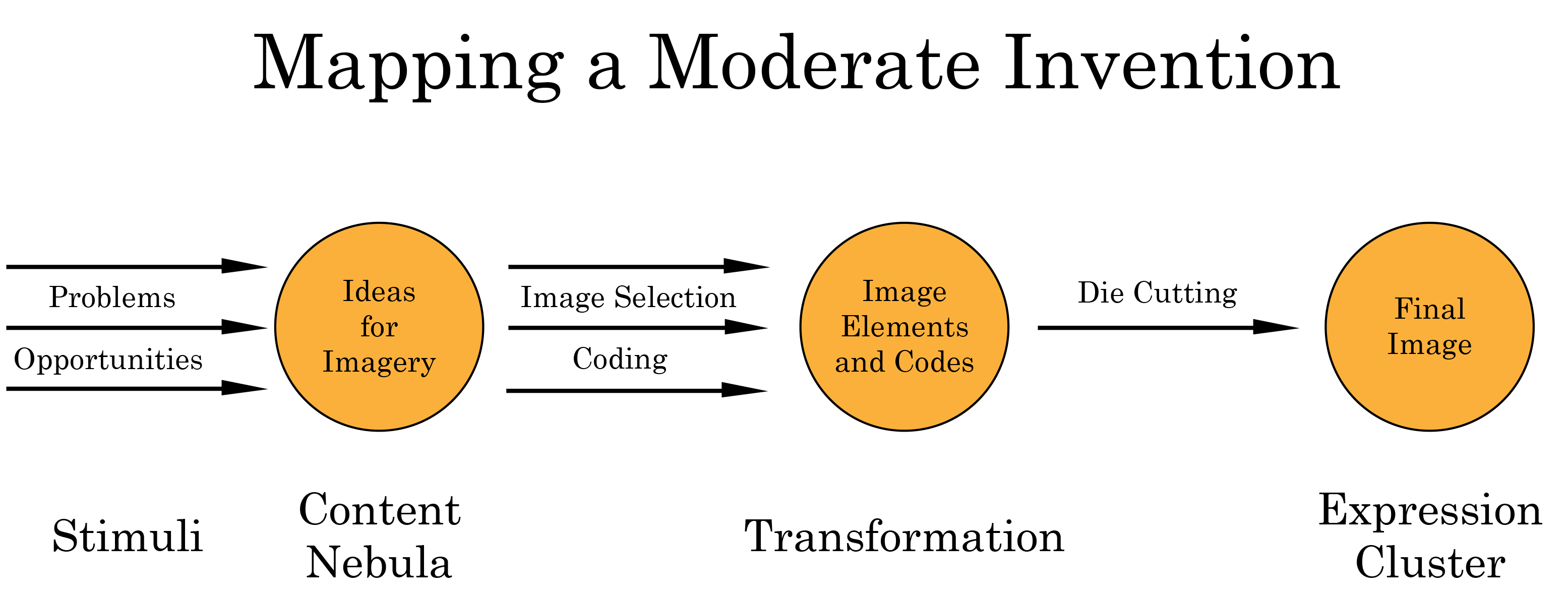
The Stimuli
Icenian Exceptionalism suggests that the confident, pioneering spirit of the Iceni could be shaken by adverse news they receive. Furthermore, the Iceni have a very strong leader, whose identification is more important than the use of the normal Celtic imagery for staters.
Before the invasion of 55 BC: The key Stimuli are the stories the Iceni hear about the invasion of Gaul and the lack of contact with the Roman leadership.
During and after the invasion of 54 BC: The key Stimuli are the successful negotiations with the Romans and subsequent restoration of Icenian confidence.
Differences after the invasions of Britain are shown in Red
| Before the invasion of 55 BC | During and after the invasion of 54 BC |
|---|---|
| Iceni are settling their territory | Iceni are settling their territory |
| Iceni are confident, pioneering people | Iceni are confident, pioneering people |
| Iceni are hearing about Caesar's invasion of Gaul | Iceni are confronted with Caesar's invasion of Britain |
| Iceni have not negotiated with the Romans | Iceni have successfully negotiated with the Romans |
| Iceni are wealthy and have much to lose | Iceni are wealthy but have lost much less than they feared |
| Iceni are uncertain about the dangers the Romans pose | Iceni understand the dangers the Romans pose |
| Iceni have gold coins to send messages to the elites | Iceni have gold coins to send messages to the elites |
| Iceni are apprehensive about the future | Iceni are confident about the future |
The Content Nebula
Icenian Exceptionalism suggests that the confident, pioneering spirit of the Iceni has been shaken by adverse news. A strong ruler is expected to do something about this. Furthermore, that strong leader does not want to use the normal imagery for a Celtic stater (no horse), but instead wants to be identified personally (use a wolf).
Before the invasion of 55 BC: The key element of the Content Nebula is that the Romans are devastating Gaulish lands on the Continent. They have seemingly vast powers that could be used against the Iceni. The ruler must do something to protect the people before the Romans invade Britain. (Info)
During and after the invasion of 54 BC: The key element is that the ruler has sucessfully negotiated with the Romans and has confidence about the future. The Romans are now a known threat, but one that can be dealt with via diplomacy. The ruler still has to convince the elites that the payment of tribute and submission of hostages was worth the loss. The devastation of Catuvellaunian territory may have provided that evidence – the Iceni were spared that disaster. (Info)
Differences after the invasions of Britain are shown in Red
| Before the invasion of 55 BC | During and after the invasion of 54 BC |
|---|---|
| Information about the invasion in Gaul is causing fear and unrest amongst the Iceni | The situation is now clearly understood by the ruler, if not the people |
| The ruler and people are apprehensive about the future | The ruler is now confident about the future and must convince the people |
| The ruler must protect the people | The ruler has protected the people but must explain the payment of tribute to the elites |
| The ruler may have to rally the people to oppose the Romans | The ruler has no military emergency to deal with |
| The ruler has much to lose if the situation isn't handled successfully | The ruler has handled the situation successfully and has everything to gain if the situation can be explained to the elites |
| The ruler must obtain the support of the people | The ruler must obtain the support of the elites |
The Transformation and Expression Cluster
Before the invasion of 55 BC: The key element of the Transformation is the use of dragons as field objects attacking the laurel wreath. This is a Coded metaphor for the Romans as an enemy with undetermined, but vast powers.
During and after the invasion of 54 BC: The field objects are changed to bears. This is a Coded metaphor for the Romans as a dangerous enemy, but a known threat. The ruler now knows Rome can be dealt with via diplomacy. The switch to bears will signal the new understanding.
The key elements of the Expression Cluster will be demons attacking the laurel wreath on the obverse. The wolf on the reverse will be used to identify the ruler. The wolf is copied from die to die throughout the series with virtually no change in the appearance of the animal. (Info) This suggests the wolf element is a Replica and should be undercoded as identifying a specific, strong ruler. (Info)
Differences after the invasions of Britain are shown in Red
| Before the invasion of 55 BC | During and after the invasion of 54 BC |
|---|---|
| Use an image of a wolf to identify a strong ruler | Use an image of a wolf to identify a strong and successful ruler |
| Use "dragons" attacking the wreath to identify a dangerous foe with unimaginable powers | Use "bears" attacking the wreath to identify a known foe with known powers |
The Sememe
Before the invasion of 55 BC: The key element of the Sememe is the danger to the realm and the call for support by the ruler.
During and after the invasion of 54 BC: The key element of the Sememe is the successful conclusion of negotiations to protect the realm and the call for support by the ruler.
Differences after the invasions of Britain are shown in Red
| Before the invasion of 55 BC | During and after the invasion of 54 BC |
|---|---|
| First Denotation obverse: Apollo wreath | First Denotation obverse: Apollo wreath |
| First Connotation obverse: coin of the realm | First Connotation obverse: coin of the realm |
| First Denotation obverse: "Dragons" attack wreath | First Denotation obverse: "Bears" attack wreath |
| First Connotation obverse: realm is under attack | First Connotation obverse: attack has been repelled |
| First Connotation obverse: "Dragons" are Romans | First Connotation obverse: "Bears" are Romans |
| First Connotation obverse: Romans have unknown powers | First Connotation obverse: Romans have known powers |
| First Denotation reverse: Wolf | First Denotation reverse: Wolf |
| First Connotation reverse: ruler is identified | First Connotation reverse: ruler is identified |
| Amalgamation Switch obverse + reverse: ruler is renowned king taking credit for dealing with Rome | Amalgamation Switch obverse + reverse: ruler is renowned king taking credit for sucessfully negotiating with Rome |
| Second Denotation: Realm is under attack | Second Denotation: Realm is no longer under attack |
| Second Connotation: Situation may be dangerous | Second Connotation: Situation is no longer dangerous |
| Second Connotation: Ruler is defending the realm | Second Connotation: Ruler has used diplomacy with Rome to defend the realm |
| Second Connotation: Elites need to prepare for war | Second Connotation: Elites no longer need to prepare for war |
| Second Connotation: Elites may be harmed by Rome if they fail to act | Second Connotation: Good relations with Rome have brought peace |
| Second Connotation: War is imminent | Second Connotation: The situation has been defused |
| Second Connotation: Good relations with Rome will bring advantages to elites | |
| Second Connotation: Good relations could begin with other tribes friendly to Rome | |
| Third Denotation: Competent ruler | Third Denotation: Competent ruler |
| Third Connotation: ruler may use military action | Third Connotation: ruler has avoided military action |
| Third Connotation: military action may save the realm | Third Connotation: diplomacy is better than military action |
| Third Connotation: ruler deserves support of the elites | Third Connotation: ruler deserves support of the elites |
Additional Thoughts
It's should be obvious that the entire semiotic analysis depends on the appearance of the Demons as "Bears". This must occur at a later date in the Norfolk Wolf series for the analysis to work. Thus, Bears should not appear on the "Wolf Right" sub-variety. If they can be identified on the earliest "Wolf Right" staters, then the entire semiotic analysis must be reconsidered. Authentication of coins should preceed analysis in this work – the Haslemere forger has been known to produce coins to fit the theories of scholars!
If the idea that Icenian confidence was restored somewhat after Caesar's departure, then further changes to that confidence could be considered. Did the failure of the Romans to re-invade Britain before 43 BC further increase Icenian confidence? Did that confidence grow to the extent that a Roman Procurator at Boudicca's doorstep created a shock that sent the Iceni into spontaneous revolt? Or, instead, had the Iceni come to know the Romans so well that they began preparations for revolt prior to 61 AD?
End


